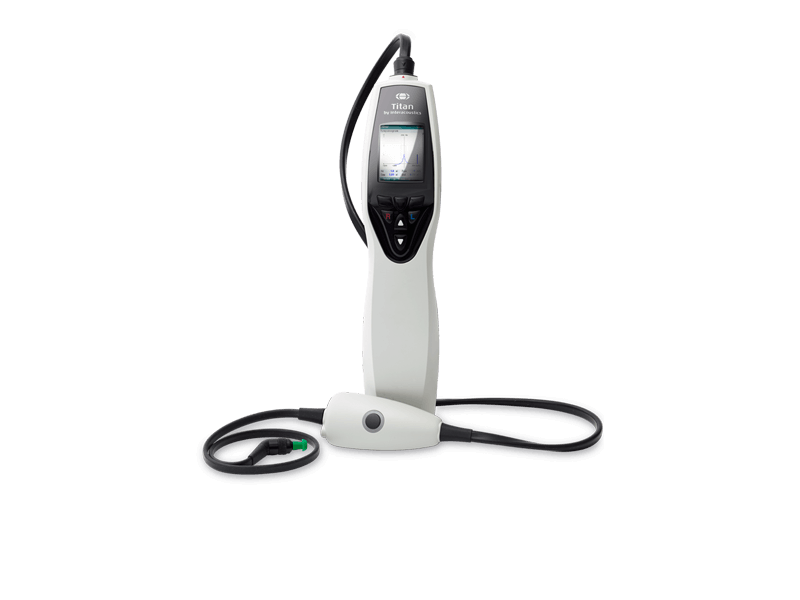
Titan Support
Available Training
-
The Variety of Decibel
-
Creating an ABRIS Test Protocol
-
Creating a TEOAE Pass/Refer Test Protocol
-
Creating a DPOAE Pass/Refer Test Protocol
-
TEOAE Probe Test
-
How to Identify a Blocked Probe Fit
-
How to Identify a Loose Probe Fit
-
How to Identify Fluid in the Middle Ear
-
How to Identify Negative Middle Ear Pressure
-
How to Identify an Ossicular Discontinuity
-
How to Identify Otosclerosis
-
How to Identify a Perforated Eardrum
-
How to Clean the Probe Tip
-
Acoustic Reflex Testing
-
Daily System Check
-
Wideband Tympanometry Research License
-
OAE Testing with PE Tubes
-
How to Change the Probe Tip
-
How to Measure eSRT
-
How to perform TEOAE on the Titan using a PC
-
Nape Electrode Montage
-
Pressurized DPOAE
-
Pressurized TEOAE
-
Selecting the Correct Ear Tip
-
Electrode Tips & Tricks
-
How to perform ABRIS on the Titan without using a PC
-
Mastoid Electrode Montage
-
How to perform TEOAE on the Titan without using a PC
-
How to perform DPOAE on the Titan using a PC
-
How to perform DPOAE on the Titan without using a PC
-
Using the Titan ABRIS module
-
How to clean the Titan probe tube
-
How to print without a database
Best Practices for OAE Testing
There are a number of things to consider when conducting OAE testing in order to ensure valid and reliable results. Consideration of the factors below will ensure an optimal OAE test.
1. Protocol selection
Ensure that the protocol that you select or create is valid for the test population and for the expected clinical outcome. Protocols generally differ between those used for Newborn Hearing Screening where a clinical outcome is based on a single test versus those used in a diagnostic follow up situation where the OAE result forms part of an overall test battery approach where many tests are analyzed to form a conclusion.
Refer to the Titan Additional Information manual for more details about test parameter considerations when creating an OAE protocol. This document also highlights parameters to consider when creating a screening TEOAE protocol: Neonatal Hearing Screening and Assessment (2002). Transient Evoked Oto-Acoustic Emission (TEOAE) Testing in Babies.
2. Probe and cable configurations
When performing OAE testing with Titan, it is important to use either the Long Clinical Extension cable with the shoulder box or the Preamplifier cable. As described in the manual, testing must not be conducted while the probe is directly connected to the Titan or directly connected to the Preamplifier cable. OAE tests should not be performed while holding the probe in the patient’s ear as this increase noise levels and the chance of incorrect delivery of the stimulus.
3. Daily Probe Test
Probe performance is crucial to OAE test results. It is common practice to conduct a probe test at the beginning of each day before starting to test on patients to ensure that the probe is functioning correctly.
-
Before conducting the probe test, ensure that the probe tip is clean and free of wax and/or debris
-
Always conduct the probe test in a quiet test environment
Only use the recommend cavity for testing. Using a different type of cavity may not detect probe faults
Refer to the TEOAE Probe Test Quick Guide for more information.
4. Cleaning the probe tip
It is important that the probe tip is clean and free of wax or other debris before conducting a test. Wax or debris in the probe tip can cause incorrect presentation of the stimulus or recording of the OAE. Refer to the manual or the Cleaning the Titan Probe Tip Quick Guide for more information.
5. Probe placement
A good probe placement will ensure a good test. Ensure that the correct size ear tip is selected so that the probe does not fall out of the ear during testing. Refer to the Selecting the Correct Ear Tip for Titan Quick Guide for more information.
6. Test environment
Ambient and physiological (patient) noise can affect the recording of an OAE response significantly. It is very important to conduct testing in a quiet environment and instruct the patient to be still and quiet during the entire test.
7. Analyzing the result
Depending on the type of test, screening vs diagnostic, the test analysis will differ. In screening, the protocol usually provides pass/refer labels for ease of understanding. In diagnostics, the stimulus, probe check, response waveform and OAE response graph along with SNR values are usually analyzed to form a conclusion of the test result.
